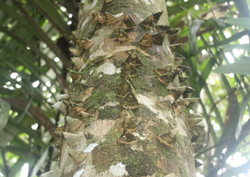A spiky tree with a reptilian bark may be able to take a bite out of the cost to produce cellulosic ethanol.
 The tree is often called a sweetgum, but it also goes by the name “alligator tree” because it does look like one. So, it’s appropriate that researchers with the University of Florida – home of the Gators – have found that bacteria growing in its wood may improve the process of making cellulosic ethanol.
The tree is often called a sweetgum, but it also goes by the name “alligator tree” because it does look like one. So, it’s appropriate that researchers with the University of Florida – home of the Gators – have found that bacteria growing in its wood may improve the process of making cellulosic ethanol.
As the team from UF’s Institute of Food and Agricultural Sciences reported in the July issue of the journal Applied and Environmental Microbiology, a strain of the wood-decaying Paenibacillus sp. bacteria named JDR-2 has a knack for breaking down and digesting one of these components, hemicelluloses.
That knack could help modify preprocessing steps for cost-effective production of ethanol.
“The acids, the heating — all of these steps you have to take beforehand are expensive, require a lot of work and, let’s face it, no one wants to work with sulfuric acid on that scale if you don’t have to,” said James Preston, the team leader and a professor in UF’s microbiology and cell science department.
“By engineering the bacteria already being used to produce ethanol to also process hemicelluloses the way this Paenibacillus does, you should be able to significantly simplify the process.”
Preston came across the bacteria a few years ago, as he was using decaying sweetgum trees to grow shiitake mushrooms on his tree farm in Micanopy, Fla. After studying the unusually uniform composition of the decaying wood, he and his colleagues went on to study the genetics of one of the bacteria digesting that wood.
The team has now mapped JDR-2’s genome, and Preston expects that, within the year, they will transfer genes behind JDR-2’s abilities to bacteria used to produce ethanol. This would be followed by the design of processes for the cost-effective production of ethanol from wood, agricultural residues and other potential energy crops.

